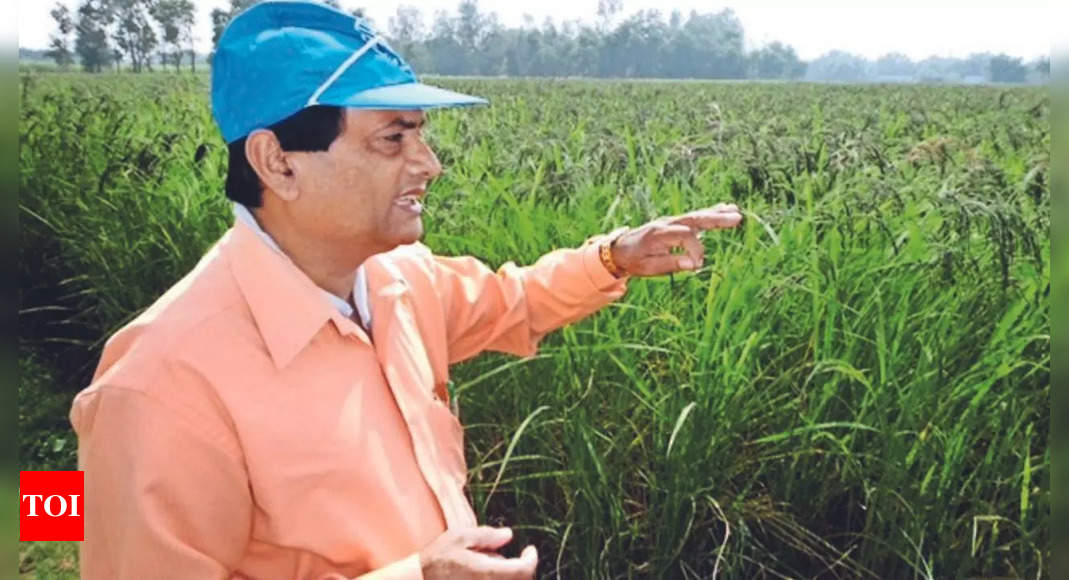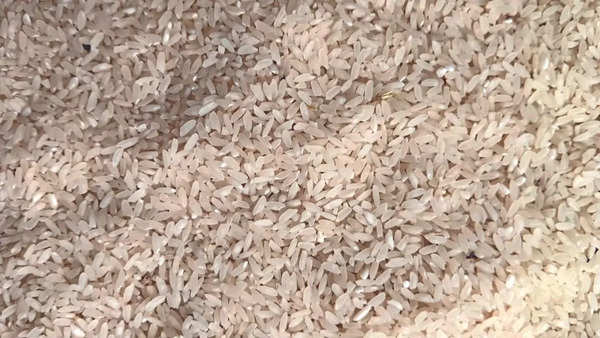
From Lucknow to London and Dumraon to Dubai, connoisseurs of food still talk about the legend of kalanamak rice, named so because of its black husk.Known for its extraordinary fragrance that is said to have drawn herds of deer out of jungle and a lightness that would allow one to gorge on it and yet never feel full, kalanamak rice was once quintessential part of dinner time stories shared at dastarkhwans of Awadh and in the royal kitchens of Banaras. But as decades went by and human greed gave way to guile, the elusive rice variety – known particularly for its health benefits – lost its acreage as much as it lost its famed qualities and gradually confined itself to myths and stories. Efforts of a few dedicated individuals, including scientists, and the Uttar Pradesh government led to the revival of the elusive rice variety in the past two decades.
It was awarded the Geographical Indication (GI) tag in 2013 which recognized Siddharth Nagar and the adjacent districts as the area where it is grown. Later, under the One District One Product (ODOP) scheme, kalanamak rice was exported from Siddharth Nagar district to Singapore and a few other Asian destinations. The rice variety also earned the Prime Minister’s award for Excellence in Public Administration 2021 and featured in the book ‘Speciality Rice of the World’ by the Food and Agriculture Organization (FAO) of the United Nations.
It’s heartening to see that a lost rice variety has finally made it to many organic outlets. It is also available on Amazon and other online platforms. And yet, the pricey packs you stumble upon in fancy outlets or online are more likely to leave you wanting. Counterfeit and adulteration are rampant as little is known or understood about kalanamak rice. This writer travelled to the remote locations associated with the cultivation and history of this rice variety and spoke to scientists, academicians and farmers to bring you the truth straight from the farm.
Kalanamak, known as kalonunia in Bengal where it is regarded as the ‘prince of rice’ and is often used in veneration, has a history directly connected to Lord Buddha.
Buddha & The Rice Of Civilisation
The history of rice cultivation in India is as old as agriculture itself. While the first evidence of agriculture is found in Neolithic site of Mehrgarh in Pakistan’s Balochistan, where wheat, cotton and barley seeds were conclusively discovered by archaeologists, first variety of wild rice were found closer home in Uttar Pradesh, in the Belan river valley of Prayagraj district. While Mehrgarh is dated approximately 8000-6000BC, carbon dating of rice grains established 7000 BC as the time of rice cultivation in Koldihwa and Mahagara archaeological sites, both on the opposite banks of Belan river, in Prayagraj district. Both sites are earliest examples of oryza sativa (Latin for rice cultivation), a rice variety first domesticated in the Yangtze river basin in China 13,500 to 8,200 years ago.
In Harappan culture, the site of Lothal has been associated with rice cultivation. The Rig Veda doesn’t mention rice, but Yajura Veda does, where it is often mentioned as ‘dhannya’. Sayana (14th century, Vijayanagar Empire) in his commentary on the Vedas uses the term ‘tandula’ for rice.
The Ramayana has several mentions of rice. In the Mahabharata, Krishna gifts a vessel, called akshay patra, to Draupadi that would always be filled with rice.

Kalanamak rice made its debut in Indian history with Gautam Buddha in his own land. When Siddhartha returned to his father’s kingdom, Kapilvastu (between the present-day Piparhawa in Siddharth Nagar and Kapilvastu district of Nepal), he was greeted by villagers at a place. According to the account of Chinese traveller Fa Hien (early 5th century), the people of Mathla village, near Bajaha jungle, asked Gautam Buddha for prasad or holy food, and he gave them grains to grow in marshy areas. According to Fa Hein, Buddha famously said, “The rice will carry a fragrance that will remind you of me.”
According to farmers, even today, the kalanamak rice variety grown between Bajaha village and Piparhawa – the place where a portion of Gautam Buddha’s ashes were discovered in a relic casket by British engineer and landowner William Claxton Peppé in 1897 – which is merely a distance of around seven kilometres on the Indo-Nepal border, has a distinctly better fragrance and taste than the rice variety grown elsewhere in the region.
Piparhawa is just 15 kilometres from Nepal’s Lumbini where an Ashokan pillar marking the site to be Buddha’s birthplace was discovered in 1896.
There is little doubt in the fact that kalanamak rice had a direct connection to both Gautam Buddha and his father’s kingdom. According to the GI registry, grains similar to kalanamak were found from excavation sites at Aligarhwa, located on the Nepal border in Siddharth Nagar – identified as the territory of Buddha’s father, king Shuddodhana. The name, Shuddhodhana, in Sanskrit, stands for ‘pure rice’.
The accidental discovery of Buddha’s relics by Peppé in 1897 took the world by storm and all details of the findings and related research were compiled in what is now known as the Piparhawa Project. However, it’s intriguing to note that there are little details of what Peppé, an estate manager and private landowner, was doing in Birdpur for a living.
According to the Asian-Agri History Foundation, the first effort at conserving kalanamak was made by the British who built reservoirs in the area to increase its production. Besides William Peppé, J H Humphrey, and Edcan Walker (zamindars of Birdpur, Alidapur and Mohana, respectively during the British Raj) led these conservation efforts.
They built ten reservoirs in the area to produce kalanamak in large quantities. They not only produced this variety for themselves but to transport it to many countries from the nearby Uska Bazar mandi, passing through Dhaka (now in Bangladesh) via the sea route.
Local farmers still point out to irrigation canals dug by these Britishers to ensure water supply to rice cultivators at all times of the year. According to village elders, they would personally ride through villages and monitor that the canals had proper flow of water to be able to reach the fields where kalanamak rice was being grown. As a result of their efforts, the rice variety had also begun to be grown in the neighbouring Basti and Gorakhpur back then.
Of these, Peppés had a larger influence, and their name is still part of the local folklore. Their house in Birdpur area is still referred to as ‘sahib ki kothi’ and a larger market town in the region is named after them. Initially called Peppéganj, it has since become Pipiganj. But the British landowners’ interest in kalanamak rice that also brought Marwari merchants to Uska Bazar in pre-Independent India didn’t go down well with farmers who were at the receiving end of their overenthusiasm.
Dinesh Chaudhary, a kalanamak rice grower from Siddharth Nagar’s Majhauli village whose ancestors were contract kalanamak cultivators for the British, said, “The British were brutal in their approach and farmers were reluctant to grow this rice variety for them. They would often beat them up if the harvest wasn’t to their satisfaction. But saying no wasn’t an option in the days of the Raj. As a result, growing kalanamak became a symbol of their slavery, something the farmers here gave up soon after Independence.”
A local folk song sung by children here in pre-Independent India, which is still at times crooned by village elders, summarises it all.
‘Ollie saheb goli khele,
Peppé saheb paiyya,
Khed-khed musarhwa ke mare
Dekh tamasa bhaiyya.’
(Oliver sahib plays golf,
Peppé sahib checks grain quality;
They chase and beat up contract farmers, And what a damn circus it was!)
Agriculture scientist Ram Chet Chaudhary, who taught at Dr. Rajendra Prasad Central Agricultural University in Pusa, Bihar, before joining the United Nations to lead a team of scientists working on rice production, studied rice cultivation in various parts of the world as part of his job.
After his retirement, Chaudhary, who worked closely with MS Swaminathan, returned to Gorakhpur, his native town, and got involved in the conservation and development of kalanamak rice. By that time (1990s), the area of its cultivation had fallen to less than 2000 hectares, from 50,000 hectares at the time of Independence.
“Growing kalanamak wasn’t an easy job for the farmers here. The rice variety needs marshy land, and the paddy grows up to a height of six feet which makes it lodge. Only those having land in the terai region could grow this variety and the yield was less and far from profitable,” he said.
Chaudhary and his team of scientists examined the carbonized rice grains found in the eastern mound at Piparhawa along with Buddha’s relics.
“I wanted to determine the qualities of the original kalanamak rice and match it with the ones that farmers were growing at that time,” Chaudhary said. He began to visit villages between Bajaha and Piparhawa in Siddharth Nagar district to collect seed samples from the farmers engaged in growing this rice variety. After 1998, he collected 250 germplasm (rice samples), characterized these, and selected the best ones for testing at the state government’s regional testing facility.Just one of these samples came close to the ancient rice samples found at Piparhawa. Since it was sample number 3, it was named Kalanamak KN3. “The sample came from a farmer named Phoolchand in Ghoswa village, barely 2 km from Mathla village in Bajaha where Buddha is said to have given seeds to farmers as prasad,” Chaudhary said.
Phoolchand’s ancestors were engaged in cultivation of this variety. They were also enrolled by the Peppé family to grow rice for them. “Traditionally, our ancestors used seeds from their own harvest and never took seeds from anywhere else. This may have preserved our crop against genetic impurities,” Phoolchand said. After years of research, KN 3 was released by the state govt in 2007 and notified by the Centre for cultivation to the farmers in 2010. “Farmers liked the aroma and the grain quality of KN 3 still avoided growing KN 3 as its long strand was prone to bending which affected its yield,” RC Chaudhary said.
Chaudhary started working on it to develop a better variety of KN 3 which could be profitable for the farmers at his organisation, Participatory Rural Development Foundation. He crossed KN 3 with an improved Sambha Masuri, another fragrant rice variety, to develop two other rice varieties – Bauna (dwarf) Kalanamak 101 and Bauna Kalanamak 102.
These had shorter plant height but were not on a par with KN 3 in terms of fragrance and texture.
In 2019, Chaudhary was successful in the notification and official release of Kalanamak Kiran variety which resulted in three-fold yield. Farmers showed readiness as Kalanamak Kiran was profitable and the state govt’s One District One Product (ODOP) and PKVY schemes helped in branding it better. In 2013, Chaudhary’s efforts led to grant of a Geographical Indications (GI) tag for the ancient rice variety, signifying its association with 11 districts – Bahraich, Balrampur, Basti, Deoria, Gonda, Gorakhpur, Kushinagar, Maharajganj, Sant Kabir Nagar, Siddharthnagar and Shrawasti.
By 2023, the kalanamak cultivation had increased to 80,000 hectares in these 11 districts.Chaudhary was recently awarded Padma Shri by President Droupadi Murmu for his efforts to conserve this rare rice variety.
In 2022, Indian Agriculture Research Institute successfully
developed and tested two new dwarf varieties: Pusa Narendra Kalanamak 1638 and Pusa Narendra Kalanamak 1652, in UP.
Kalanamak rice is rich in micronutrients such as iron (four-times the normal rice variety) and zinc (16.97ppm). It has 11% protein, almost double that of common rice varieties. It has a low Glycaemic Index (49% to 52%) making it “sugar-free” and suitable for diabetics. Besides, it has low amylose (21%, against 24% in normal rice varieties) and has beta carotene present in its grain (.42mg), something that’s absent in the grains of other rice varieties (according to analysis done at R-FRAC, dept of horticulture, UP. Chaudhary et al., 2021). The central government came out with its Nutri-Farm scheme in 2013, intending to promote food crops that offer critical micronutrients to improve the nutrition status of the vulnerable section of society. Kalanamak rice was the only rice from north India to be selected as a nutri-crop for this scheme. Under the state govt’s ODOP scheme, kalanamak rice was branded as ‘Buddha Home rice’ and exported to Singapore in 2021.
The name caught the fancy of Buddhist nations and this rice variety is now being regularly re-exported to Japan, Malaysia, Cambodia, and a few other Southeast Asian countries.
A few other measures were also taken at the grassroots level. To address farmers’ issues, Farmer Producer Organizations (FPOs) that nurture the growth of the farmers in the district by providing forward and backward linkages were formed. Each FPO had seed-providers as members which helped them estimate demand so that they could provide adequate supply. A common facility centre for kalanamak processing was developed and farmers were provided linkages for sale on various platforms, including e-commerce sites like Amazon and Flipkart.
But with branding came bad practices. Middlemen began to procure rice from farmers, mix them with other rice varieties of similar grain size and sell them in open markets as well as on online platforms. As a result, out of ten packs of kalanamak rice one purchased online or even in stores, nine turned out to be fake, or heavily adulterated. The govt will have to develop a mechanism to check bad practices in kalanamak trade in due course of time.
With the extension of kalanamak rice cultivation in 11 districts of eastern UP, the fragrance and texture of the rice have taken a tumble as compared to original KN 3, the heritage rice variety. RC Chaudhary said, “I have heard about such issues. KN 3 is the heritage rice variety with traces of wild rice qualities. Besides, terrain, soil and climate of the particular area each play a part in rice cultivation. Our research is far from over. The good thing is that people are talking about, growing and getting to eat the kalanamak rice variety.” The French used a word for wine quality, ‘terroir’, which is the complete natural environment in which a particular wine is produced, including factors such as the soil, topography, and climate. Perhaps, ‘terroir’ plays a role in kalanamak rice cultivation too. While agricultural research and govt’s efforts have expanded area of cultivation and brought it out of fables to the food tables, the fragrance of Buddha still pervades the land he once walked.







